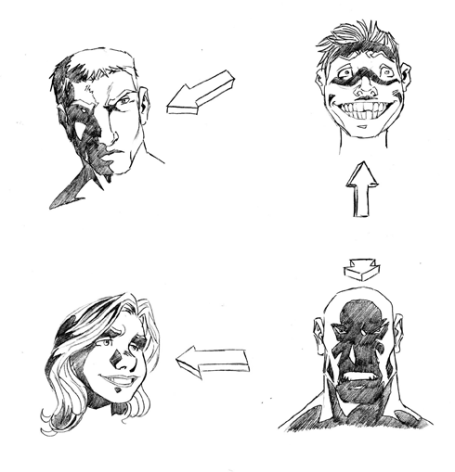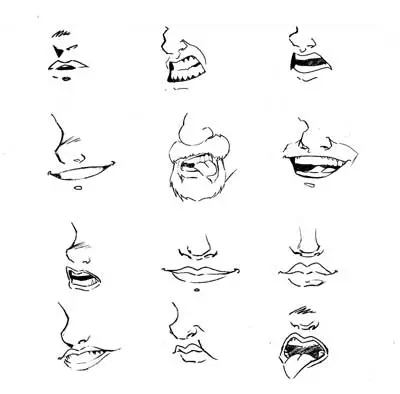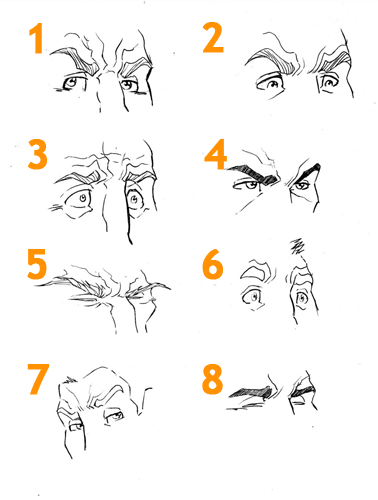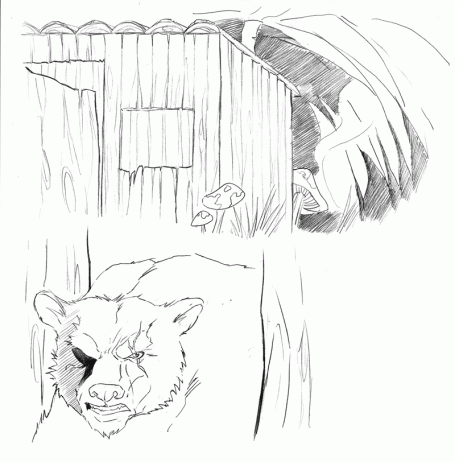Posts tagged ‘emotion’
How to do shading
This week we are going to look at knowing where your shadow areas are going to be.
This will all depends on where your light source is coming from.
I usually do this in colour (we will cover this in a future blog), but a lot of artists do the shadows in the drawing phase. So if you’re that way inclined have a look at the drawing for this week.
From left to right. The first guy is a typical male character and the light source is coming in from the right. Therefore all the shading would be on the opposite side. Notice what happens with eyes, nose and cheeks. Make sure that your shading takes into account the contours of the face.
Secondly, the smiling character. The light in this case is coming from underneath his face. This is probably the hardest to do because all the shading would be in areas which usually have no shading. So, this can be rather confusing, just plan correctly.
The 3rd drawing of the woman. The light source is in the same place as the 1st drawing although her head is slightly turned towards it. Look at the significant difference it makes to how you shade her. Now the shading doesn’t cover half the face anymore.
And lastly in the fourth drawing the light is coming from behind the character. So all his forward features would be in shadow.
When you choose a light source you need to consider what impact the shading will have on the character. Is this going to work with the rest of the emotion that you are trying to convey?
Tip: When you are trying to decide what to shade and what not to shade, look at the parts of the face that protrude. Chances are that those are the parts that aren’t shaded, they would create shadow behind them.
Practice makes perfect with this one. Experiment and have fun!

How to draw a mouth
Like hands, a lot of people battle with drawing mouths. Choosing to use either the line mouth or teeth clenched mouth, all the time.
Too often we see characters speaking to each other with gritted teeth, what’s that about? Like before, it’s all about having fun and experimenting.
I use to sit for hours on end trying to get the perfect nose and the perfect eyes and in the end they were never perfect. Practice by jotting down a sketch as quickly as you can with the aim of just having fun. It’s a lot less frustrating that way.
So, with regards to the pic this week, the top two rows are men’s mouths and the bottom two rows are those of women. The big difference between the two is the fullness of the lips. I did this on the upper lip of the first guy mouth to add a good looking feminine-ish look to him.
Start the mouth by deciding what expression you want to capture then draw a basic outline of the shape, open for shocked or shouting, smiling for happy.
Now add the smaller details, the hair, the lips the teeth and tongue. Perhaps there is a mole on the top lip or a scar across the lip. I varied the mouths with things like hairy faces, fuller lips, funny expressions. Have a close look at each and give it a shot at doing some of your own.

how to draw a mouth
Drawing eyes and eyebrows to give your characters more personality
This week we look at how eyebrows and eyes can affect expressions and how they can depict different character personalities.
Picture 1 & 2
Sharp angles on eyebrows are usually used to depict bad guys, but the can also be used for neutral characters. I had a bit of fun with the top two and it’s pretty easy to tell what they are thinking.
Picture 3
In the third picture the eyebrows were placed to show fear. This is pretty universal and easy to grasp. When working with eyebrows it’s important to not forget the rest of the forehead, note how each emotion adds furrows or wrinkles to the face.
Picture 4
In the next illustration I’ve drawn your typical calculating, bad guy. To get this effect use black, heavy eyebrows to draw attention to the character’s personality.
Picture 5 – 8
With the last four I just had fun. The old Chinese shop owner, the goofy fat guy, the narcissistic hero, and a dark haired guy flashing a goofy smile – Note how the cheeks go up and the eyes squint.
Examine each of these and just have fun! Create a few characters of your own using what you see here!

Things that shape our gnomes personality
Picture all the elements that make up a character. His home, his village, his arch nemesis.
Here I started with his home. I drew his mushroomed old rotted wooded home in the cave where his people live. I mean, if you lived in a cave you wouldn’t seem very approachable and you’d end up very withdrawn. So that adds to his shyness. And every story has to have a villain or someone that’s a contrast to the hero in some way.
In this case, I drew up a villainous bear that lurks in the woods where the gnomes go to look for food. As with all good characters he needs to have some physical characteristic that makes him stand out from others. So, I gave him a few scars and made him look pretty mean. On a side note. When drawing animals, try to stay away from realism. This is a comic tutorial, so give your animals some comic qualities. Like the human eyes and mouth I gave him. Makes it similar to what Disney used to do with their animated movies. Makes it your work. Not a realistic copy. So with the bear in the woods it makes the gnomes very fearful. You see the story developing?
Give us some thoughts on where you see the story going.

Sheena’s note: Scars are an interesting addition to a character. It shows that they have been in fights and lived. This probably means that the other characters have come off worse than them. Unless it is a very particular scar, like the strangulation mark on the gnome’s neck. This shows a trauma to a character.
Description and dialogue, how much is too much?
Lord of the rings, the movies were awesome. The books were terrible. Before you send out a lynch mob, hear me out. The movie managed to capture emotions, the grandness and the beauty without messing it up with too much dialogue and over sharing. The book was long winded and over descriptive.
Yes, he was creating a new world, but did we really have to have it in so much detail? I believe that dialogue and description should only ever be used to drive the plot forward or to tell us more about the character or a new environment. Give me a brief sketch of the place, it’s a warehouse with wooden beams running across the ceiling.
Set the mood by telling me that the light is interrupted by the ceiling fans. Tell me about the stale smell of fried foods and the crates piled on the far corner. That is enough to set the mood and to establish where we are. Most importantly, make it interesting and keep it simple. Readers want to connect with your work. Using high brow language makes you seem like a smarty pants. Yes, there is an argument for those few people who like to read the complicated pretentious stuff, but Paper Movie Books are for the average Joe who wants to be entertained. That’s what we do. Entertainment.
The dialogue is there to reveal things about the characters, not the plot. This is important, don’t have your character say, “Oh, no. There is a bomb.” Rather describe the bomb and describe his reaction. Then have him say something that relates to his character, like, “My father always said I should watch out for brunettes.” Much more entertaining. The Lord of the rings books waffled on for hours about things we didn’t need. It used complicated language. Tolkien had way too much time on his hands and even developed a language. Seriously, most readers don’t care. And yes, the books have a huge, cult like following and yes people love them, they have an awesome original story, so I am not knocking them entirely, just the way they are written.
How to add emotion to your illustrated characters
Tip on how to add life to your character.



